Intel’s Last Atom in Smartphones: A 2018 Benchmark
by Ian Cutress on March 28, 2018 1:00 PM EST- Posted in
- Smartphones
- Intel
- Atom
- x86
- SoCs
- Spreadtrum
- Senwa
- SC9853i
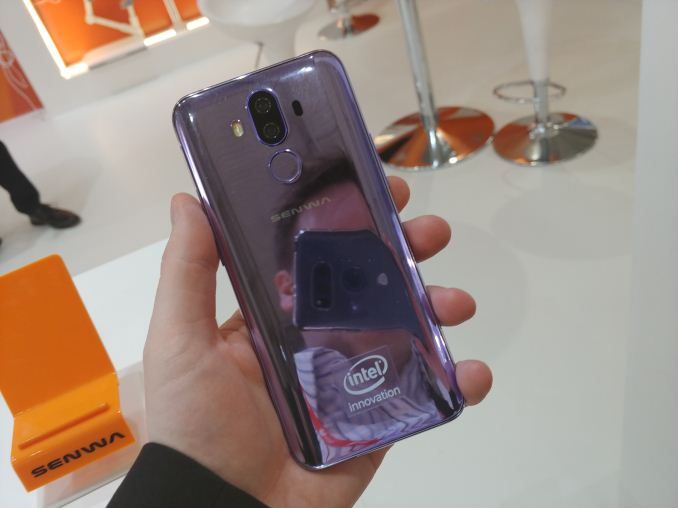
Intel's push into smartphones over the last 10 years has been well documented, as well as the subsequent downfall after its Broxton smartphone SoCs were cancelled in April 2016. This was not the ‘end’ for Atom in smartphones: an agreement between Intel and Spreadtrum, a low-end SoC vendor based in Asia, kept Intel SoCs going into smartphones for the low-cost market. These chips contained Intel Atom x86 cores, graphics, Spreadtrum modems, and were built in Intel’s fabs.
The two chips to come out of the agreement so far were the SC9861G-IA in 2017, followed by the SC9853i at the end of last year. These chips have most found themselves in Senwa phones, specifically the LS9718 and LS9918 that were launched at Mobile World Congress this year, and are in devices primarily marketed to Latin America and Africa.
The Spreadtrum SC9853i, the latest SoC to come out of the agreement, is actually the lower end unit. It uses eight Intel Airmont cores at 1.8 GHz, a dual core Arm Mali-T820 GPU (down from PowerVR), a 1080p video engine (down from 4K), and a maximum supported camera resolution of 16MP. The modem inside is suitable for up to 4G Cat 7 / 300 Mbps download.
We managed to get hold of the Senwa LS9718 at the show, at the Senwa booth which had a big Intel logo. The booth was fairly devoid of people, or at least, those that were there were not actively engaging with the devices. I only managed to start to have a look around before being pounced on by a Senwa representative from Latin America. He didn’t seem to understand much about what I was doing there as press, and I couldn’t get any more information beyond ‘these are Intel phones’ out of him, but he was happy to stand and watch (at a distance of 6 inches) while I ran a benchmark.
The Senwa LS9718 as a phone is a typical super-midrange phone, with a 5.7-inch HD+ IPS screen in an 18:9 format, with 3 GB DRAM and 32 GB storage, and a battery of 3000 mAh. It felt reasonable to hold, it had a dual camera (16MP + 8MP), a fingerprint sensor, and actually kind of felt like an old Huawei phone to be honest. According to Senwa’s press releases, there was also the LS9918 on the stand featuring the same SoC, but with a more premium 5.99-inch HD+ IPS screen.
The goal of looking at the device was to actually see what I could get out of the SoC underneath. Intel cores in smartphones are, at this point, a relative novelty. It still relies on Android to be compiled for x86 for example, as well as the intricacies of graphics interconnect and all the usual terminology with Arm based-devices but done in the context of Intel’s large x86 mantra.
So here is the one result I managed to get: A score of 22.65 in Jetstream, running on the native browser. The test took around 15-20 minutes to complete, so I was almost pushing my luck if I had asked to download PCMark or something, especially with the Senwa rep basically breathing down my neck. To put that into context with our benchmark data:
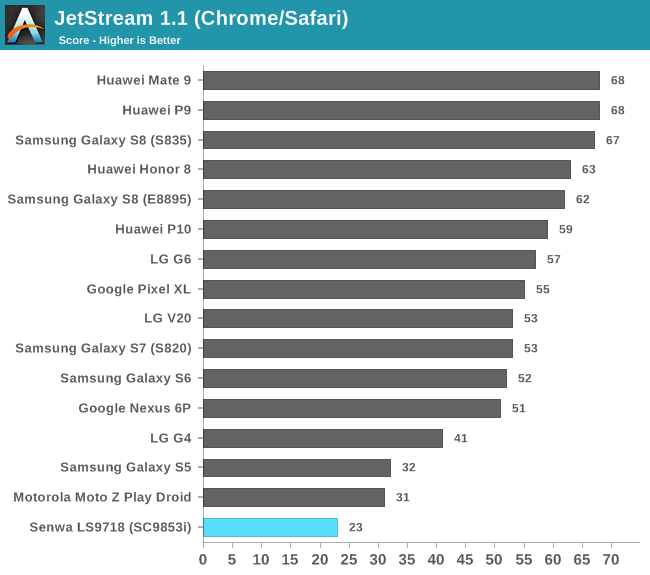
It is worth noting that the Senwa device was using its native browser, which will lead to some variation. During MWC we also played a bit with the ASUS Zenfone 5, with its Snapdragon 636, an octa-core Kryo 260. That unit scored 45.34 using Chrome in regular mode, and 54.13 in CPU boost mode. Even compared to the results in the graph above, the performance puts the device well below the LG G4, the Samsung Galaxy S5. The Moto Z Play Droid is a Snapdragon 625, an octa-core A53 configuration up to 2.0 GHz, showing that the Atom cores just cannot keep up.
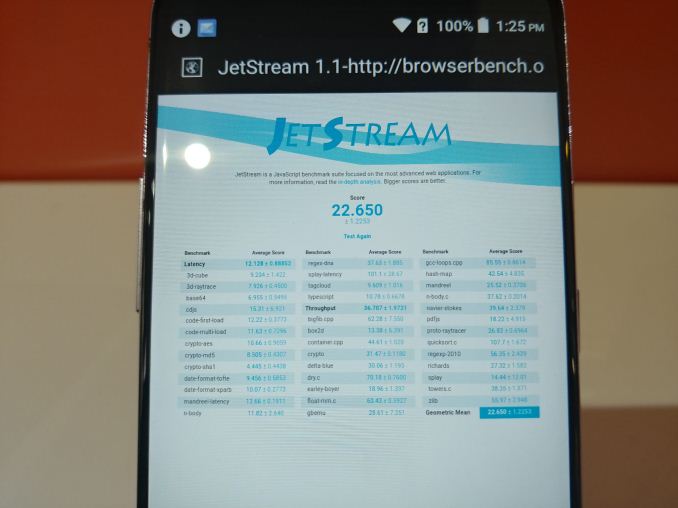
For detailed numbers, click to see the full resolution
Also worth mentioning is that the device started to get very warm to touch. Not uncomfortably so, but the combination of workload and heat soak was noticeable, especially over the 15 minutes it took for the test to run. For a javascript test like JetStream, I really would not expect a device to heat up as much as it did.
Funnily enough, in between MWC and today, Intel and Spreadtrum have agreed to extend their SoC alliance. The two companies are set to work together to develop SoCs integrating Intel’s 5G modems for deployment by the end of 2019. The difference here is that Spreadtrum plan to use Arm CPU cores, rather than Intel x86 cores. As a result, the SC9853i might be the last smartphone SoC with an Atom inside. So despite the new launches of devices from companies like Senwa, it is a rather meagre ending to a smartphone processor line that has been on life support for a while. This deal is also odd, given that Spreadtrum normally deals in the low-end SoC space, while 5G will be a premium addition to begin - either Intel is targeting 5G at the low-end as well, or Spreadtrum is gearing up for a high-end SoC, built on Intel's 14nm.
Sources: The Linley Group, PR Newswire


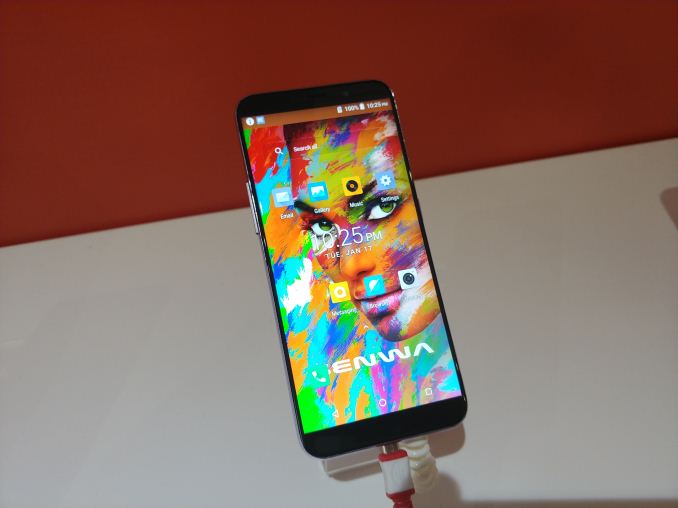
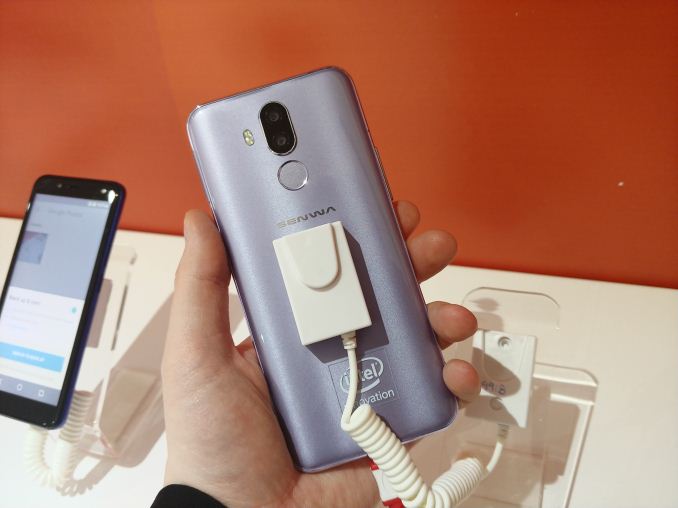








56 Comments
View All Comments
karthik.hegde - Wednesday, March 28, 2018 - link
No one os going to bat an eye on ARM GPU in Intel SoC?Alexvrb - Wednesday, March 28, 2018 - link
We didn't bat an eye with PowerVR GPUs in Intel SoCs for many years. Going back even to integrated desktop graphics.serendip - Thursday, March 29, 2018 - link
Atom really is at the end of the line. Intel dropped the 2W-4W chips for tablets and concentrated on Atom for cheap desktops which also didn't take off. I would love to see an 8-core Atom with the latest cut-down HD Graphics engine for $200-300 Windows tablets but that's a pipe dream now. The x5-Z38xx chips are decent, on par with a mid level C2D, but they're outclassed by the latest Qualcomm, Samsung and HiSilicon flagship chips. If only Windows Subsystems for Linux ran on ARM...AntonErtl - Thursday, March 29, 2018 - link
Just for perspective, here is another benchmark on a Silvermont (22nm variant of the Airmont tested here), and a Cortex-A53 (results are times, so lower is better):From <https://www.complang.tuwien.ac.at/franz/latex-benc...
1.052s Celeron J1900 (Silvermont) 2416MHz (Shuttle XS35V4) Ubuntu16.10 64-bit
2.32s Odroid C2 (1536MHz Cortex A53) Ubuntu 16.04 64-bit
Even factoring in the differences in clock rate compared to the phones in this article, I would expect the Airmont to outperform the Cortex A53 by a factor of 1.26 on this benchmark on these phones. So the JetStream benchmark seems to favor the A53 quite a bit more than the LaTeX benchmark.
Wilco1 - Monday, April 2, 2018 - link
Either way a 3-way OoO core being just 1.26 times faster per clock than a 2-way in-order core is extremely poor - it means Cortex-A55 should be about equal...ZolaIII - Friday, March 30, 2018 - link
Old S650 scores 44.847 mid delta in with Chrome. Saying this just to remind you how how all you need are two more power OoO core's for the Web & in generally 93% of the times as a refract how really bad engendered are all the new SoC's recently.serendip - Friday, March 30, 2018 - link
How did you get those results? On MIUI?I'm using your cpu and schedule scripts on Lineage and I'm not seeing the A72 cores kick in during the test. I don't know if it's because of the config script or if it's an issue with Chrome Beta.
ZolaIII - Friday, March 30, 2018 - link
Used regular chrome. In my script HPM is set to flag similar tasks as high performance (within 240ms) and skip CPU scheduler (interactive) completely pushing maximum performance almost instantly. On S652 it even gets 5~6%+ performance as the hotplug (core_ctl) is set so that core 04 & 06 are always idling one's so all L2 is utilised & with exclusive access.So I don't really know what's the problem in your case. Is hotplug working?
serendip - Friday, March 30, 2018 - link
I reflashed the ROM and your CPU script, re-enabled hotplugging and now I get 40 on JStream. The 2x A72 cores run at full speed, A53 cores 0 and 2 run at full speed and the rest are idle. It's supposed to be that way I guess?Anyway Intel missed the boat on heterogenous computing. The A53s save a lot of power, the A72s pack a big punch only when needed. An Atom with 4x Goldmont and 2x Core M cores would be a screamer with excellent battery life, if only those two architectures could share caches.
ZolaIII - Friday, March 30, 2018 - link
Well for this benchmark it is supposed to be like that as browser's (among most other things) are only SMP 2. Yes I used same typology on small core's too.If Intel made SoC like that it would be probably priced 300+$ so no one would buy it. Also they would had to do a big R&D on heterogeneous before so it's a lost battle anyway.
Who knows me by in the future we see Falkor derivat's (what ever dragon it would be called) on mainstream mobile SoC's. It's more probable so as Samsung & Apple as prime competitors are pushing it & QC will have to respond.
For me ideal SoC would be an 2x A75 & 4x A55 with big juicy GPU like A630 on 22nm FD-SOI, naturally without idiotic L4 cache found on on S845. Described as it is it would cost approximately half the price of S845 & achieved 70% performance (both CPU and GPU) in real usage so it would be a real improvement & still with lower DTP. I would pay a full price for it as for S845 if it would be coupled with 4GB HMB 2 (which is about the same price as 8BG of LPXDDR 4 and 20$ extra from the SoC for interconnect) this would make it on pair in CPU side with S845 but GPU would got a wings & would be 2x the speed of current A630 found on S845. That SoC would needles to say be much better for Android and especially for mobile VR (on Android and especially self stand)...
Who knows... We will see both eventually.